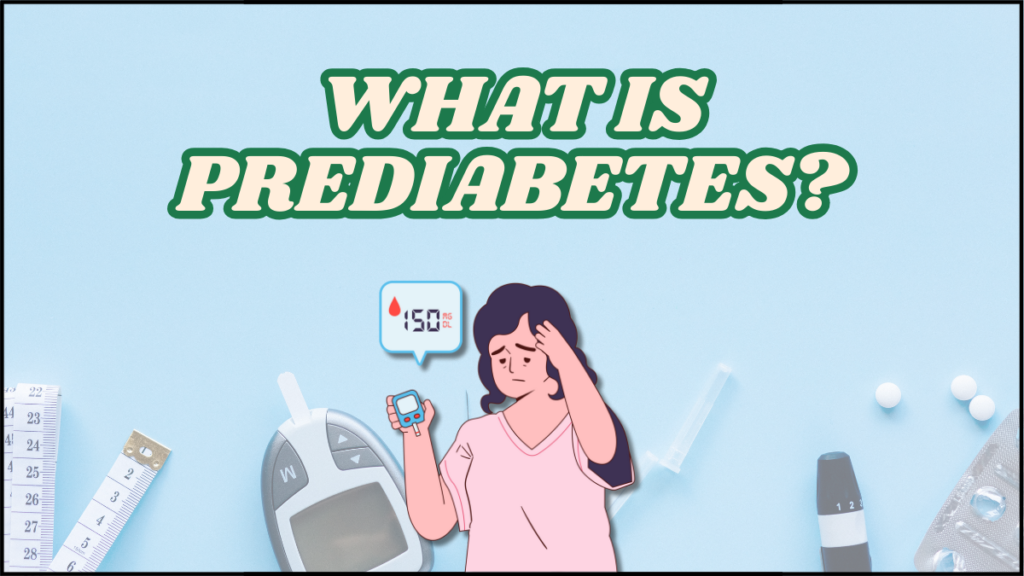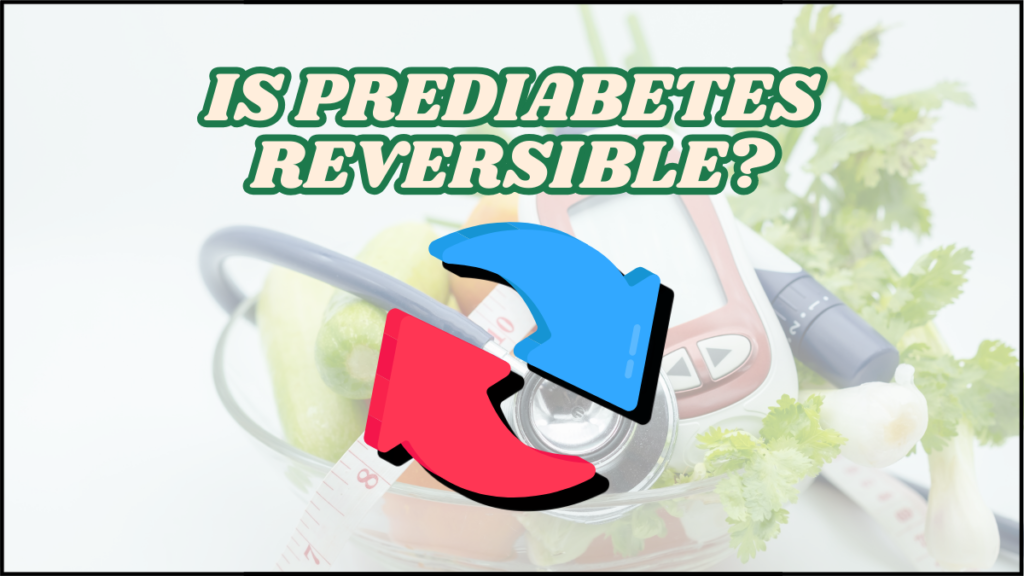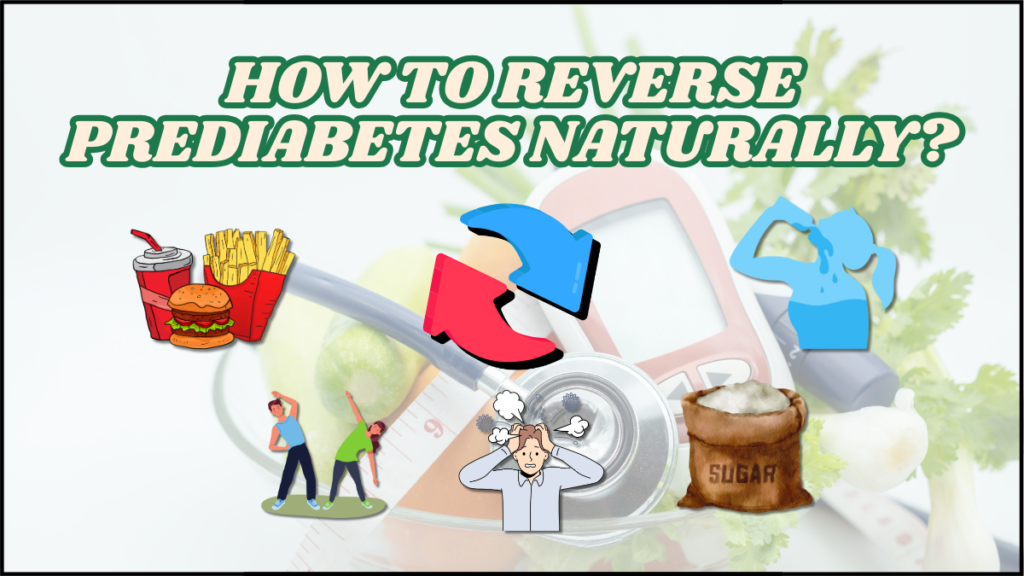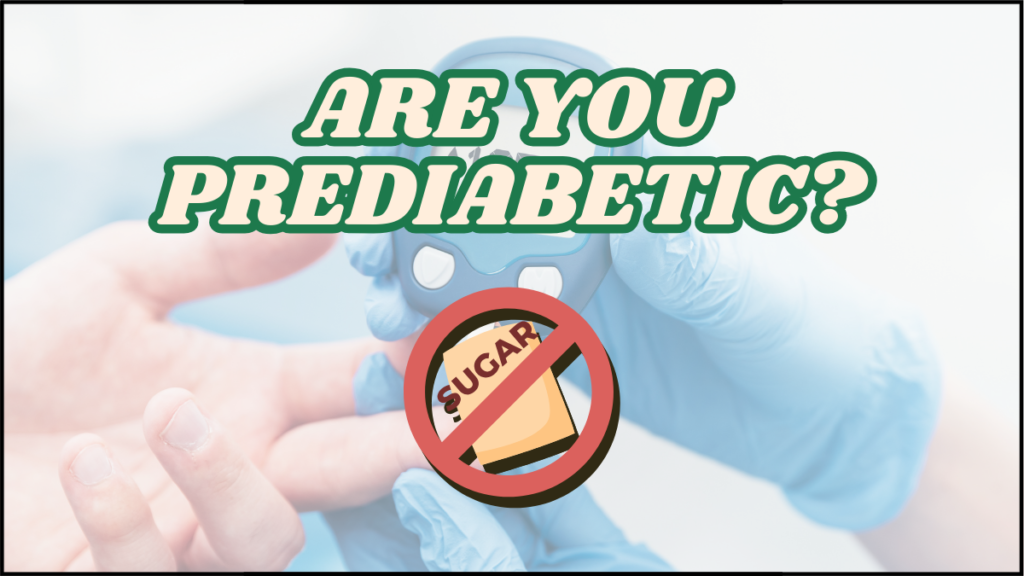Imagine waking up one day and being told that your body is giving you an early warning sign a chance to prevent a serious disease before it starts. That’s exactly what a prediabetes diagnosis is.
It’s not diabetes yet, but it’s a sign that your blood sugar levels are higher than normal, and if left unchecked, it could turn into type 2 diabetes.
The good news? Prediabetes is reversible!
With the right lifestyle changes, you can bring your blood sugar back to a healthy range and prevent diabetes altogether.
But here’s the catch, prediabetes often has no obvious symptoms. Many people don’t even realize they have it until it’s too late. That’s why it’s important to understand the warning signs, risk factors, and proven ways to reverse prediabetes naturally. In this article, we’ll cover:
Table of Contents
If you or someone you love has been diagnosed with prediabetes or if you just want to take control of your health, this guide will give you everything you need to turn things around before it’s too late.
Let’s get started! 🚀
What Is Prediabetes?
Imagine your body as a car, and your blood sugar levels as a fuel gauge. When your blood sugar is normal, the gauge is in the right range. When you have prediabetes, it’s like the gauge creeping into the warning zone you’re not in danger yet, but you’re getting close.
Prediabetes is a condition where blood sugar levels are higher than normal but not high enough to be classified as type 2 diabetes.
It means your body is struggling to use insulin effectively, causing sugar to build up in your blood instead of being used for energy.

Why Should You Be Concerned?
- More than 1 in 3 adults in the U.S. have prediabetes—and most don’t even know it!
- If left untreated, prediabetes can turn into type 2 diabetes within 5-10 years.
- Type 2 diabetes can lead to serious health problems, like heart disease, kidney failure, and nerve damage.
- The good news? Prediabetes is reversible! With simple lifestyle changes, you can bring your blood sugar back to a healthy level.
Are you looking for for the best supplements out in the market to help you manage your blood sugar levels, then check out the Shop by Smart Sugar Control!
Signs and Symptoms of Prediabetes
One of the most challenging aspects of prediabetes is that it often develops silently. Many people have prediabetes for years without realizing it because the symptoms are subtle or easy to overlook.
However, your body may still be sending warning signs you just need to know what to look for.
While not everyone with prediabetes will experience noticeable symptoms, certain early warning signs can indicate that your blood sugar levels are higher than normal.
Let’s take a closer look at these symptoms and how they affect your body.

1. Increased Thirst and Frequent Urination 🚰🚽
Why it happens:
When your blood sugar levels are too high, your kidneys work harder to filter and remove the excess sugar from your bloodstream. This leads to more urine production, which means you need to urinate more frequently. As a result, your body loses fluids, making you feel thirstier than usual.
What to watch for:
- You’re drinking more water than usual but still feeling thirsty.
- You wake up multiple times during the night to use the bathroom.
- You notice that you need to urinate frequently throughout the day.
Why it matters:
Excessive thirst and frequent urination are some of the earliest signs of high blood sugar levels. If left unmanaged, it can lead to dehydration and increase the risk of developing type 2 diabetes.
2. Feeling Tired All the Time 😴
Why it happens:
Prediabetes affects how your body processes glucose (sugar), which is your primary energy source. When your blood sugar is too high, your cells can’t absorb glucose properly, leaving you feeling tired—even if you’ve had a full night’s sleep.
What to watch for:
- You feel exhausted after eating, especially meals high in carbs or sugar.
- You experience afternoon energy crashes, even with enough sleep.
- You feel like you lack motivation or struggle to concentrate.
Why it matters:
Constant fatigue is a sign that your body isn’t using insulin effectively. This is a key symptom of insulin resistance, which can eventually lead to diabetes if not addressed.
3. Unexplained Weight Gain or Difficulty Losing Weight ⚖️
Why it happens:
Insulin is a hormone that helps regulate blood sugar levels. When your body becomes insulin resistant (a hallmark of prediabetes), it struggles to process sugar properly. This causes your body to store more fat, particularly around the belly area.
What to watch for:
- You’ve gained weight, especially around your midsection, without major changes to your diet.
- No matter how much you exercise or diet, losing weight feels impossible.
- You have frequent hunger cravings, making it difficult to control portions.
Why it matters:
Being overweight, especially around the abdomen, increases the risk of developing type 2 diabetes, heart disease, and metabolic syndrome. However, the good news is that even a 5-10% weight loss can significantly improve insulin sensitivity and reverse prediabetes.
4. Dark Patches of Skin (Acanthosis Nigricans) 🖤
Why it happens:
When insulin resistance begins to develop, insulin levels in your blood rise. High insulin levels stimulate skin cells to grow rapidly, leading to dark, velvety patches in certain areas of the body.
What to watch for:
- Darkened skin on your neck, armpits, elbows, knuckles, or groin.
- Skin feels thicker or slightly rougher than usual.
- The affected areas do not go away with regular washing or scrubbing.
Why it matters:
Acanthosis nigricans is one of the most visible early signs of insulin resistance and prediabetes. If you notice these changes in your skin, it’s important to check your blood sugar levels.
5. Sugar Cravings and Increased Hunger 🍩🍕
Why it happens:
When your blood sugar is unstable, your body struggles to regulate insulin properly. This leads to rapid spikes and crashes in blood sugar, making you crave quick sources of energy—mainly sugar and refined carbohydrates.
What to watch for:
- You feel hungry shortly after eating, even if you had a big meal.
- You crave sweets or high-carb foods like bread, pasta, and chips.
- You experience mood swings or irritability when you don’t eat for a few hours.
Why it matters:
Frequent hunger and sugar cravings can lead to overeating, further increasing blood sugar levels and worsening insulin resistance. Cutting back on processed sugars and eating balanced meals with fiber, protein, and healthy fats can help stabilize blood sugar levels.
6. Blurry Vision 👀
Why it happens:
High blood sugar levels can affect the fluid balance in your eyes, causing the lens to swell. This temporary change can result in blurry vision.
What to watch for:
- You suddenly notice blurry vision, especially after eating.
- Your eyes feel dry or irritated more than usual.
- You struggle to focus when reading or looking at screens.
Why it matters:
Blurry vision caused by high blood sugar is reversible once blood sugar levels are controlled. However, long-term uncontrolled blood sugar can lead to diabetic eye disease and vision loss.
Why Recognizing The Symptoms Early Is Important?
Ignoring prediabetes symptoms can allow the condition to progress into full-blown diabetes. The sooner you recognize the warning signs and take action, the easier it is to reverse prediabetes naturally through lifestyle changes.
What You Should Do Next:
✅ Monitor your symptoms – Keep track of any changes in your body.
✅ Get a blood sugar test – A simple fasting blood sugar test or an A1C test can confirm if you have prediabetes.
✅ Make small lifestyle changes – Eating better, exercising, and managing stress can help bring your blood sugar back to normal.
Prediabetes doesn’t mean diabetes is inevitable—it’s a wake-up call to make healthier choices. By recognizing the early signs and taking action, you can regain control of your health and prevent diabetes before it starts! 🚀
Is Prediabetes Reversible?
✅ Yes, prediabetes is reversible!
The most important thing to know about prediabetes is that it is reversible, but only if you take action.
Think of prediabetes as a yellow traffic light. It’s a warning sign that you’re approaching a dangerous intersection, but you still have time to stop and turn in a different direction. The key is to make lifestyle changes now, before prediabetes progresses to type 2 diabetes.
If left untreated, prediabetes often leads to type 2 diabetes within 5 to 10 years. However, studies show that by making healthy changes, you can lower your blood sugar levels and return to a normal range effectively reversing prediabetes.

How to Reverse Prediabetes?
Prediabetes occurs due to insulin resistance, which means your body is struggling to use insulin properly. This causes blood sugar to rise. The good news is that insulin resistance can often be improved or even completely reversed through lifestyle adjustments.
Here’s how it works:
- When you eat healthy foods, your body gets the right nutrients to process sugar efficiently.
- When you exercise, your muscles use up extra sugar in your bloodstream, helping to lower blood sugar levels naturally.
- When you reduce stress and sleep better, your hormones stay balanced, which improves insulin sensitivity.
By addressing these root causes, you can help your body restore normal blood sugar levels without the need for medication.
How Long Does It Take to Reverse Prediabetes?
The time it takes to reverse prediabetes varies from person to person. Some people see improvements in just a few weeks, while others may take months or up to a year.
Factors That Affect How Quickly You Can Reverse Prediabetes:
✅ How early you catch it – The sooner you take action, the faster you can see improvements.
✅ Your current lifestyle – If you already eat well and exercise a little, small changes might work quickly. If not, it may take longer.
✅ Consistency – Reversing prediabetes isn’t about quick fixes. Long-term habits matter the most.
The key is to be patient and stay consistent. Even small improvements in diet, exercise, and daily habits can lower your blood sugar over time.
Why Reversing Prediabetes Matters?
If prediabetes progresses to type 2 diabetes, it can lead to serious health complications, including:
❌ Heart disease – High blood sugar damages blood vessels, increasing the risk of heart attacks and strokes.
❌ Kidney damage – Diabetes is one of the leading causes of kidney failure.
❌ Vision problems – High blood sugar can lead to blurry vision and, over time, blindness.
❌ Nerve damage – Diabetes can cause pain, numbness, and tingling in your hands and feet.
The good news? Reversing prediabetes not only prevents diabetes but also protects you from these serious health problems.
By taking action now, you can: ✅ Regain your energy and feel better overall
✅ Lose weight and improve your metabolism
✅ Reduce your risk of future health problems
✅ Take control of your health naturally—without medication
How to Reverse Prediabetes Naturally?
Reversing prediabetes doesn’t require expensive medications or drastic measures—it’s all about making smart, sustainable lifestyle changes that improve your body’s ability to regulate blood sugar. The best part? Even small changes can have a big impact!
By focusing on healthy eating, regular physical activity, stress management, and quality sleep, you can lower your blood sugar levels, improve insulin sensitivity, and prevent type 2 diabetes altogether. Let’s explore the most effective, science-backed ways to naturally reverse prediabetes and take control of your health! 🚀

1. Make Smart Food Choices 🍏
Your diet plays a huge role in controlling blood sugar. The goal is to eat foods that keep your blood sugar stable and avoid those that cause sudden spikes.
What to Eat More Of:
✅ High-Fiber Foods – Whole grains, vegetables, beans, nuts, and seeds help slow down sugar absorption.
✅ Lean Proteins – Chicken, fish, tofu, and legumes keep you full without spiking blood sugar.
✅ Healthy Fats – Avocados, olive oil, nuts, and fatty fish (like salmon) help reduce inflammation and insulin resistance.
What to Cut Back On:
❌ Refined Carbs – White bread, pasta, rice, and baked goods cause rapid blood sugar spikes.
❌ Sugary Drinks – Sodas, energy drinks, and fruit juices contain high amounts of sugar.
❌ Processed and Fast Foods – Packaged snacks and fried foods often contain unhealthy fats and added sugars.
👉 Tip: Try the “Plate Method”—fill half your plate with veggies, one-quarter with lean protein, and one-quarter with whole grains.
2. Get Moving Every Day 🚶♀️
Exercise helps your body use insulin better and lowers blood sugar levels naturally. You don’t need an intense workout routine—just 30 minutes of movement a day can make a difference.
✅ Easy ways to stay active:
- Walk after meals 🚶♂️
- Take the stairs instead of the elevator 🏢
- Dance while cooking 🍳💃
- Try yoga or stretching 🧘
Even small amounts of physical activity help lower blood sugar and improve insulin sensitivity.
3. Manage Stress 😌
When you’re stressed, your body releases cortisol, a hormone that raises blood sugar levels. Over time, chronic stress can lead to insulin resistance.
✅ Simple ways to reduce stress:
- Practice deep breathing exercises
- Listen to calming music 🎶
- Spend time in nature 🌳
- Meditate or try mindfulness 🧘♂️
- Get 7-9 hours of quality sleep each night 😴
Lowering stress levels helps keep blood sugar in check and improves overall health.
4. Cut Back on Sugar 🍬
Too much sugar increases insulin resistance and raises blood sugar levels. Reducing sugar intake is one of the fastest ways to reverse prediabetes naturally.
✅ Easy swaps:
- Drink water or herbal tea instead of soda
- Choose dark chocolate (70% or more cocoa) instead of milk chocolate
- Replace processed snacks with nuts or fruit
👉 Tip: Read food labels! Many packaged foods contain hidden sugars under names like corn syrup, fructose, and sucrose.
5. Stay Hydrated 💧
Drinking enough water helps flush out excess sugar from your bloodstream and prevents dehydration.
✅ Aim for at least 8 glasses of water per day
✅ Carry a reusable water bottle to sip throughout the day
✅ Add lemon, mint, or cucumber for a refreshing taste
Are you looking for for the best supplements out in the market to help you manage your blood sugar levels, then check out the Shop by Smart Sugar Control!
Final Thoughts: Take Charge of Your Health Today
Prediabetes is not a life sentence it’s a wake-up call and an opportunity to take control of your health before it turns into type 2 diabetes.
The best part? You have the power to reverse it naturally through simple, sustainable lifestyle changes.
By recognizing the early signs, making healthier food choices, staying active, and managing stress and sleep, you can bring your blood sugar levels back to normal and avoid future complications.
Remember: Even small changes make a big difference. Losing just 5-10% of your body weight, adding daily movement, and cutting back on processed sugars and refined carbs can significantly improve insulin sensitivity.
So, what’s your first step? Take action today.
Whether it’s swapping soda for water, taking a 10-minute walk, or choosing whole foods over processed ones, every positive step brings you closer to a healthier, diabetes-free future. Your body is giving you a second chance don’t wait until it’s too late. Start now, stay consistent, and reclaim your health! 💪🚀
References
This article was written from the knowledge of prediabetes, diabetes prevention research, and expert health guidelines from reputable sources like: ✅ Centers for Disease Control and Prevention (CDC) – www.cdc.gov
✅ American Diabetes Association (ADA) – www.diabetes.org
✅ National Institute of Diabetes and Digestive and Kidney Diseases (NIDDK) – www.niddk.nih.gov
✅ Harvard T.H. Chan School of Public Health – www.hsph.harvard.edu
✅ Mayo Clinic – www.mayoclinic.org
